The JVMI participated in a side event about Iran’s 1988 massacre at the 36th session of the United Nations Human Rights Council in Geneva on 14 September 2017.
The event called on the OHCHR to launch an international commission of inquiry into the 1988 massacre of more than 30,000 political prisoners in Iran.
Speakers at the event included Tahar Boumedra, former head of UNAMI’s human rights office and the lead author of two JVMI reports into the 1988 massacre; Alfred de Zayas, UN Independent Expert on the promotion of a democratic and equitable international order; Rama Yade, former Human Rights Minister of France; Dr. Alejo Vidal-Quadras, former Vice President of the European Parliament and current President of the international committee In Search of Justice (ISJ); Kirsty Brimelow, Chair of the Bar Human Rights Committee of England and Wales; and Laurence Felhmann Rielle, Swiss Federal Councillor. The event was moderated by Perviz Khazai, the representative of the opposition National Council of Resistance of Iran (NCRI) in Nordic countries.
A number of survivors and family members of victims of the 1988 massacre also addressed the event about the scenes that they had witnessed at the time.
Alejo Vidal-Quadras started the event by stating that he was encouraged by the recent report of Asma Jahangir, the UN Special Rapporteur on the situation of human rights in the Islamic Republic of Iran, in which the issue of the 1988 massacre was raised. Vidal-Quadras detailed how the information campaign conducted by the opposition about the massacre has had a very large impact on public opinion and officials both outside and within Iran. He pointed out that the majority of victims of the massacre belonged to the opposition group People’s Mojahedin (PMOI or MEK) and he emphasised that the best source of evidence about the massacre are the PMOI members currently residing in Tirana, Albania.
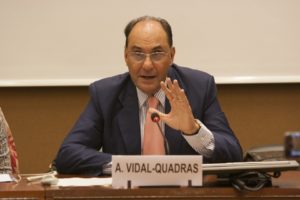
Vidal-Quadras further explained the link between the massacre and the current leadership of the Iranian government, including the fact that two subsequent Ministers of Justice appointed by President Hassan Rouhani have been directly implicated as central actors in this crime against humanity. He concluded that due to the continued presence of the perpetrators at the highest levels of government and judicial system there can be no credible national investigation and the next report of the Special Rapporteur should therefore take the step to recommend the UN refer the case to the International Criminal Court.
Finally Vidal-Quadras entreated European and other Governments to put human rights first when dealing with Iran. The credibility of the democratic world has been damaged by years of appeasement towards the Iranian Government despite their gross violations of human rights, he said. One way to reclaim that credibility would be to include language about the 1988 massacre from the Special Rapporteur’s report in the UN resolutions on the mandate of the Special Rapporteur and on the human rights situation in Iran, he added.
Tahar Boumedra gave an overview of the extensive research into the 1988 massacre carried out by the JVMI since the launch of the organisation last year. The JVMI has gathered details about the victims, alleged perpetrators, sites of mass graves as well as applicable laws and treaties, he said. Boumedra explained that the events of 1988 would not have been possible without the Iranian Government setting up a machine of mass killing which remain in place today.
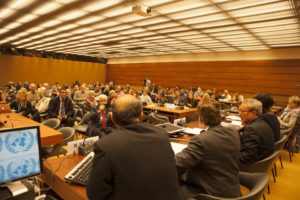
Boumedra went on to show some of the evidence that has been gathered since the publication of the organisation’s first report in February. There have been multiple public confessions by the perpetrators, currently high ranking officials in the Iranian state. Not least, there were several admissions of guilt during the presidential campaign earlier this year, he said.
Boumedra emphasised that although the exact extent of the massacre is unknown there is no doubt whatsoever that thousands of people were executed in an extra-legal process. The killings were systematic and widespread, with as many as 70 death committees set up in all the major cities in Iran.
Boumedra questioned whether it is normal that after twenty-eight years there has not been any attempts at an investigation by the Iranian authorities. The families have a right to know what happened to their loved ones, how they died and where they are buried. He recommended that the UN take a new approach to this issue. He encouraged all relevant UN mandate holders to investigate the events of 1988.
Alfred de Zayas, Independent Expert on the promotion of a democratic and equitable international order started his intervention by stating that he believed in the cause presented by JVMI and ISJ and in particular that he wished to align himself with Boumedra’s call for an international commission of inquiry. He argued that the matter of the 1988 massacre in Iran impacts international order, truth and justice. It is not simply an Iranian matter. The Independent Expert reminded that there have been countless UN resolutions condemning impunity for human rights abuses and crimes against humanity around the world. The 1988 massacre is not any different; impunity must end, he said. If someone like the former dictator of Chile, Augusto Pinochet, could be brought to justice, the same should be possible for the perpetrators of this crime. The Independent Expert praised the work of the Special Rapporteur on the situation of human rights in the Islamic Republic of Iran but argued that an international commission of inquiry is necessary in the case of the 1988 massacre.
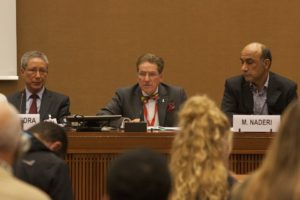
Rama Yade reminded the audience that there can no peace without justice because without justice there is always the risk of recurrence of the crime. All it took was a fatwa from the Supreme Leader for thousands of people, political prisoners as well as prisoners of belief and conscience, to be killed. Yade asked, without justice, what is to prevent it from happening again? While acknowledging the ‘important and excellent work’ of the Special Rapporteur and her report, Yade argued that the international community must go further and accept its responsibilities. In her view, a fact finding mission is not enough, there must be an independent international commission of inquiry.
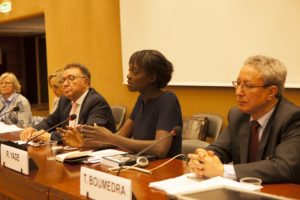
The former French Secretary of State outlined one of the largest potential problems of any investigation into the events of 1988, the fact that the Iranian authorities consistently find, intimidate and punish any individual who cooperates with UN Special Procedures or human rights organisations. In order for an investigation to be successful, witnesses must be able to come forward without fear of reprisals, which means the international community must be ready to protect witnesses. Yade further argued that for justice to be done there must be legal sanctions against those found guilty and this requires the involvement of the International Criminal Court, which in turn requires that the Security Council take action.
In response to those who might be intimidated by Iran and the struggle ahead, Yade argued that the only strategy which has proven effective against regimes like that in Iran is strength, not cowardice. She reminded that Iran has much more too lose from lost trade and business, which means we should not be intimidated by Iranian threats of economic losses if we put human rights first. In terms of regional and security policy it is clear that Iran will not play a positive role in the region, such as ending the war in Syria, regardless of the actions of the world community when it comes to human rights in general and the case of the 1988 massacre in particular.
Yade ended her intervention by praising the ‘brilliant report’ by Boumedra compiling the evidence to date and encouraged everyone to do what they can to help the Iranian people become involved and present their evidence.
Kirsty Brimelow took the floor to encourage states and organisations to follow the lead of Canada which officially recognised the 1988 massacre as a crime against humanity in 2013. In what could potentially be described as a genocide, executions took place every thirty minutes all over Iran, she said. She argued that these mass killings might have been dressed up in judicial wrappings but clearly violated all international principles of fair trials and independent judicial systems.

Brimelow went on to argue that even in cases were atrocities have already happened, states have responsibilities and must aid reconciliation by recognising the crime, informing relatives and taking measures to ensure non-recurrence. This particular crime was pivotal to the development of human rights in Iran. Centrally placed perpetrators were promoted and two Ministers of Justice are among those accused of carrying out the mass killings, she said. The current extreme rate of executions of Iran is also a product of the past and unlikely if not for the 1988 massacre.
Brimelow reminded the international community that over one hundred accused perpetrators have been identified. It is not possible, as is too often the case and which have impeded other calls for justice, for perpetrators to hide behind some faceless grouping. These individuals can and should be brought to justice, but what is the appropriate venue? Brimelow argued that Iran has proven both unwilling, given the twenty-eight years without any investigation, and unable, given the lack of an independent judiciary, to hold its own tribunal. An international inquiry in some form, potentially a hybrid tribunal such as that attempted in the case of Sri Lanka, is necessary. A remedy is urgently required, she added.
Laurence Felhmann Rielle recounted her many interactions with in particular the women who are fighting for justice in the case of the 1988 massacre. She expressed how impressed she was with their activism and struggle in the face of extreme obstacles put up by the Iranian authorities.
Felhmann Rielle denounced in the strongest terms the horrible events of 1988. One third of those executed were women, among them pregnant women, teenagers and old women. She argued this case, and the information campaign of the families and PMOI, has an enormous impact on Iranian society to this day. She reminded the audience that while the PMOI paid the highest price they were not the only victims and that this campaign is for all those impacted by the crime.
She hailed the report of the Special Rapporteur as a step forward but not enough. Although the report means we can no longer ignore the facts of what happened in 1988, the international community must also keep up the pressure on the Iranian Government. Felhmann Rielle pointed out that many non-governmental organisations such as Amnesty International and FIDH have also demanded that the internal community take action. As part of that action, she argued there must be protection for opponents of the Iranian Government and witnesses.
Tom Syrin, visiting scholar at the Norwegian Centre for Human Rights, explained why the particular atrocity of the 1988 massacre needs to be urgently addressed. He drew on several historical examples to show that atrocities and crimes against humanity often follow large losses of legitimacy for non-democratic regimes. In the case of the 1988 massacre, the Iran-Iraq war had severely challenged the Iranian Government and this loss of prestige and legitimacy led to the repressive actions culminating in the mass killings. Syrin argued that in the case of the current Iranian Government, its support is based in part on the clergy and in part on the merchant class which will only support the government as long as money is diverted to them. The Iranian constitution also stipulates a goal of eternal expansion of the revolution. With the economic troubles of Iran and setbacks in its regional policy, particularly in Syria, there is thus a large risk of renewed repression and recurrence of the events of 1988. There is a clear connection between a lack of rule of law and the use of external crises to conceal and motivate repression.
Syrin ended his intervention by emphasising that the public and repeated admissions of guilt by perpetrators is a jurist’s dream and must move the Human Rights Council to action. If the UN Human Rights mechanisms are not to risk their own legitimacy, these warning signs must be followed by substantial actions.
Zohreh Bijanyar spoke out on behalf of the family members of those killed in the 1988 massacre. She told the audience of her sister, a human rights activist, who was arrested in the summer of 1988 and soon after executed along with more than 30,000 other political prisoners following a fatwa by the Supreme Leader Ayatollah Khomeini.
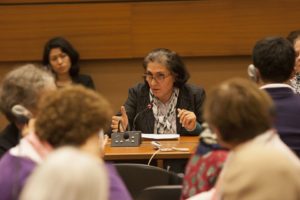
She spoke of the pain to see at least three known members of the death committee which sentenced the prisoners to their executions currently occupying high positions in the Iranian judiciary. Thousands of families, including her own, have waited twenty-nine years to know why their loved ones were killed, when, where and how they were killed and where their bodies were buried. On behalf of these families she called for the truth to be established through an international commission of inquiry and reiterated that the pain is still present every day for the families.
Mostafa Naderi recounted the story of his imprisonment. He was first arrested in 1980, he was only a student at the time, rounded up with many other youngsters who wanted to ensure that they did not lose the freedoms they had gained after the 1979 revolution. The only charges presented against him were selling newspapers and participating in protests which were perfectly legal at the time.
He spent in total five years in solitary confinement and endured extensive torture and pain. In 1988 he was suffering from internal bleeding of the kidneys as a consequence of being whipped with cables and was often unconscious and hospitalised. When he was brought back to his prison cell after he recovered, he was told by the remaining few prisoners that the others had been executed. The regime had, using the so-called death commissions, separated the prisoners into those that would live and those that would die. Between 150 and 200 people had been executed every night. The doors to most cells were open, their former inhabitants gone and only their bags with nametags left, he recounted. Many had been told that they were being brought to see their families and instead led to their executions. Only 200 of the previously 12,000 of the prisoners in his prison had survived. Naderi told the audience about how he was released three years after the massacre and how he managed to flee the country.
Naderi explained that the massacre neither started nor stopped in 1988. It started with the execution of the first political prisoner and continues to this day. He ended his remarks by asking for a commission of inquiry not just for those that have already died but also for those currently awaiting execution in Iranian prisoners.

Simin Nouri, President of the Association of Iranian Women in France, highlighted that one third of all those executed in 1988 were women. She explained that women have always had a very prominent role in all social movements in Iran and that through the decades much progress had been made. Despite the grave misogyny which faces the women of Iran, their struggle still continues. Nouri urged all Iranian women to come forward with their stories, to record all the details of what they have witnessed and experienced, and submit it to both the members of the panel and to the UN. She ended her intervention with the hope that the women of Iran can count on all in the audience and the international community to help them.

